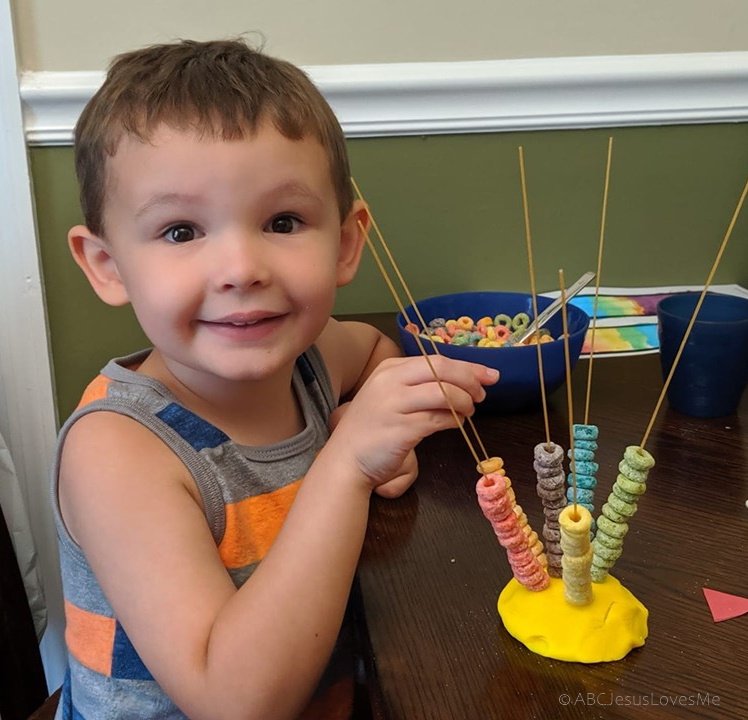
Fine motor activities are essential for preschoolers as they help strengthen hand-eye coordination, improve dexterity, and support early writing skills. These activities not only promote physical development but also encourage focus and problem-solving in young children. Explore this page for fun, engaging fine motor activities that will help your child grow these essential skills. Plus, many of these activities make excellent learning centers in a preschool setting!
You'll discover on this page fun activities:
Fine motor skills are critical for preschoolers as they form the foundation for many everyday tasks. Developing these skills helps children gain control over their hand and finger movements, which are essential for tasks like holding a pencil, cutting, getting dressed, and manipulating small objects. Fine motor activities also promote brain development, as they require coordination between the hands and the eyes. Through activities such as playing with play dough, building, or stringing beads, children not only enhance their physical abilities but also boost their concentration, patience, and problem-solving skills. These activities play a vital role in preparing children for more complex tasks in school and life.
If a child struggles with or dislikes activities like coloring, writing, or manipulating small objects at an age-appropriate level, they may have a delay in fine motor skills. Insufficient muscle strength can often show up as a dislike of coloring, using scissors, or buttoning a shirt.
The good news is that there are many fun activities to help strengthen fine motor skills! The activities below can easily be incorporated into a child's playtime. If you would like specific ideas, the 1-5 Year Preschool Curricula contain weekly fine motor activities tailored to the development of the child.
And if I may share a quick thought—while scrolling on a screen with an index finger can be fun, it's important to remember that fine motor practice really happens when a child physically manipulates objects. The activities listed below strengthen hand muscles and build essential skills. For more ideas, check out "When Technology is Out of Control in Your House."
To introduce a child to puzzles, start with peg puzzles—those with large knobs on the pieces. These are great for helping the child develop the pincer grasp, where they use their thumb and index finger to pick up and place the pieces. As the child gains confidence and strength, you can move to puzzles with smaller knobs to continue strengthening those fine motor skills. Peg puzzles come in a wide variety of themes, such as shapes, letters, colors, and animals, which also provide opportunities for additional learning. These puzzles help children not only build physical strength but also enhance their cognitive development as they engage with the images and themes.
After mastering peg puzzles, move to chunky wooden puzzles. These puzzles have larger, easier-to-grip pieces but require more coordination to place correctly, helping to further strengthen the pincer grasp.
Once the child is comfortable with chunky puzzles, try interlocking puzzles. These puzzles, often made of wood, cardboard, or foam, require the child to fit pieces together without the use of knobs. This step encourages more hand-eye coordination and control, as the child must align the pieces correctly. My children loved jumbo floor puzzles.
Watch a child confidently learn through engaging, hands-on activities in the ABCJesusLovesMe Preschool Curriculum. With a focus on both academics and biblical values, this program nurtures development in every area, all while making learning fun. Click to discover how we can support a child's educational journey!
Playing with play dough is an important activity for young children as it helps develop fine motor skills, creativity, and sensory exploration. The molding, pulling, and pushing or play dough strengthens small muscles.

Using the Shape Posters (found in the 2 Year Workbook) and the Number and Letter Posters (found in the 3 Year Workbook) as a guide, form letters and numbers with play dough. When ready, remove the learning mats and have the child form the shape, letter, or number without the guide.
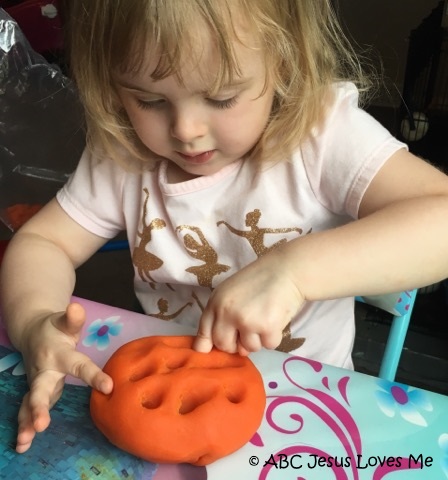
Hide large pony beads, coins, or buttons in the play dough for the child to discover. Encourage the child not to use her thumb but to use the weaker fingers instead.
Using scissors requires fine motor skills, as it involves precise hand-eye coordination, control of hand muscles, and the ability to manipulate small objects. When a child uses scissors, they strengthen their hand and finger muscles, particularly the thumb, index, and middle fingers, which are essential for tasks like writing and grasping a pencil. Regular scissor practice helps children refine their fine motor skills, improve coordination, and develop greater independence in everyday tasks.
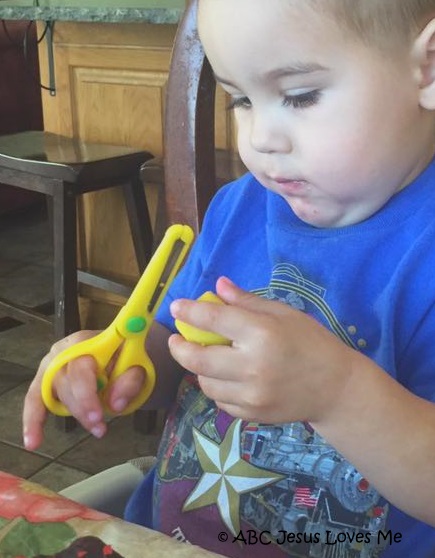
Cutting play-dough snakes is a wonderful way to begin scissor use (introduced in the 2 Year Curriculum). This simple procedure allows the child to focus solely on closing and opening the blades. Be sure that the child's elbow stays next to their body and that the thumb is on top.
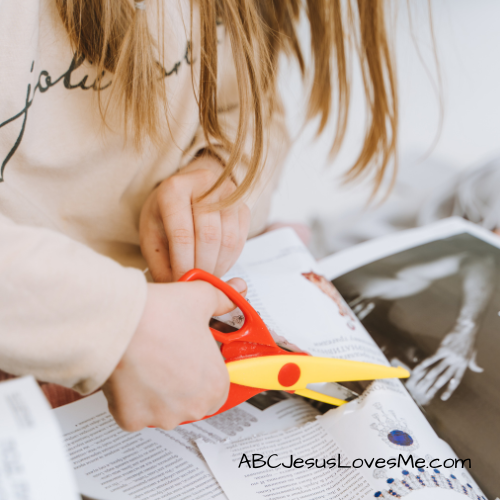
Cutting up old magazines and junk mail is a great way to let your child practice scissor skills. While it can be a bit messy, it's easy to clean up with a broom and dustpan—and sometimes, learning is messy! Creating crafts are another opportunity for children practice scissor use. The ABCJesusLovesMe 1-5 Year Curricula strategically includes age-appropriate scissor use to build these skills over time. As your child cuts, ensure their elbow stays close to their body and that their thumb is positioned on top of the scissors.
Visual perception is the brain's ability to interpret and make sense of the visual information received through the eyes. This skill is vital for reading, writing, and problem-solving. Our Visual Perception Curriculum is a comprehensive workbook designed to strengthen these skills through fun and engaging activities, helping a child build a strong foundation for learning.
Squeezing a glue bottle, manipulating a glue sticks, and peeling and placing stickers are simple but effective ways to strengthen a child's fine motor skills. These activities engage hand muscles while helping children practice coordination and control.
Larger stickers with smooth edges are easier to use.
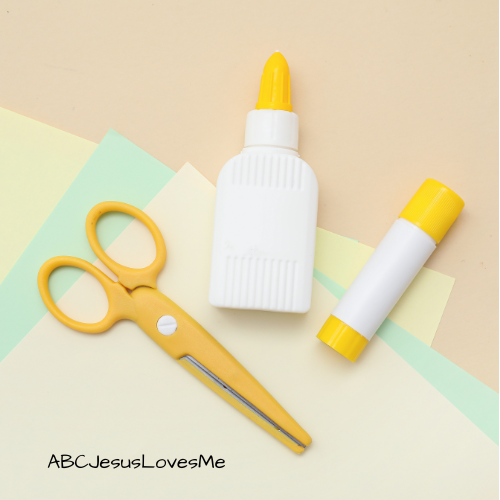
Squeezing a glue bottle or manipulating a glue stick requires precise hand movements and builds muscle strength in the fingers and hands. When using a glue bottle, train the child to use "Just a dot, not a lot." The control in squeezing just the right amount strengthens the thumb, index finger, and middle finger - all used in the correct pencil grip. Encourage children to create simple art projects or glue small items like sequins or cotton balls onto paper to practice using both tools. You can also set up activities like gluing shapes or lines, which require focus and careful handling.
I used to think stickers were just for decorating or adding details. But after watching a young child place stickers on paper, I realized how much fine motor skill is involved in peeling up a sticker. Peeling and placing stickers helps develop the pincer grasp, an essential part of fine motor development. Use larger sticker with smooth edges to begin. If the child asks for help, gently pry up the stubborn section allowing the child to peel the rest. Children can use stickers to decorate, sort by color or shape, or follow patterns, all while improving their coordination and dexterity.
Threading and beading activities offer an excellent way for children to develop fine motor skills while engaging in fun, hands-on learning. These tasks involve carefully placing small items like beads or cereal onto a string or line, helping kids strengthen their hand-eye coordination, visual perception, and muscle control. With each movement, children gain essential skills that support their overall development.
Start your child’s beading practice with large beads. My kiddos started with a large bead set by Melissa and Doug. Be sure to tie a knot around the first bead to keep others from slipping off the end. There are plenty of beading options are available to purchase.

Use large pasta (like macaroni or penne) or cereal to thread onto string or pipe cleaners. Wrapping tape around the end of the string can help make threading easier. Once done, tie the string into a loop to create fun shapes, necklaces, or bracelets. You can also use different pasta shapes or cereal colors to practice sorting and color recognition.
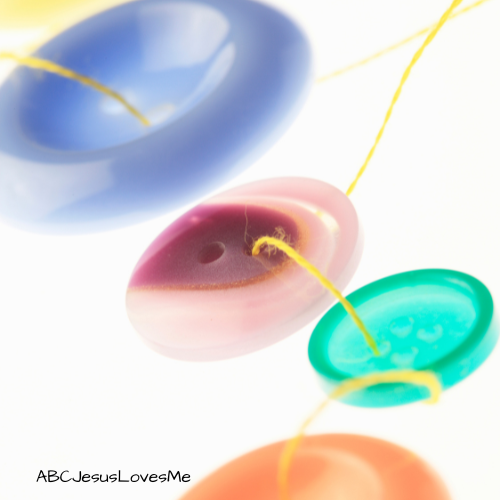
Let children thread large buttons onto string or yarn to practice hand-eye coordination. For older children, you can introduce threading with a plastic needle to further develop their skills and introduce sewing.
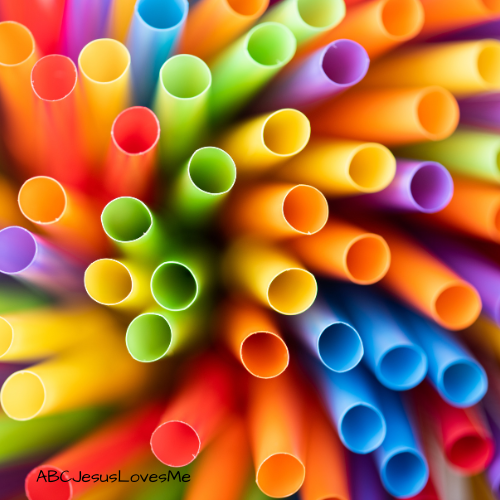
Once children master cutting play dough, they can move on to cutting drinking straws. Instead of discarding the cut pieces, use them to make straw necklaces by threading the pieces onto a string or pipe cleaner.

Collect large leaves and punch holes in them using a hole puncher. Let children thread yarn through the holes to create a beautiful garland—perfect for fall or Thanksgiving decorations.
For older preschoolers, you can practice letter recognition and word formation using ABC's Lacing Beads.

Place uncooked spaghetti vertically into play dough and let children thread Froot Loops, Cheerios, or small beads onto the spaghetti without breaking it. This activity is great for practicing fine motor skills, sorting, and creating patterns.
View more Sorting and Pattern Activities
Embark on a kaleidoscope of learning with our Color Packet. Bursting with vibrant colors and endless opportunities for creativity, this printable resource invites children on an exciting educational journey.
Magnetic or paper dolls provide an excellent way to strengthen fine motor skills as the child manipulates the small pieces, helping with hand-eye coordination and dexterity. The careful handling of the dolls and their accessories encourages gentleness, while matching outfits or items develops visual perception and pattern recognition. For younger children, magnetic, wooden sets are available to purchase, while free paper doll printables for older children are available on the web.
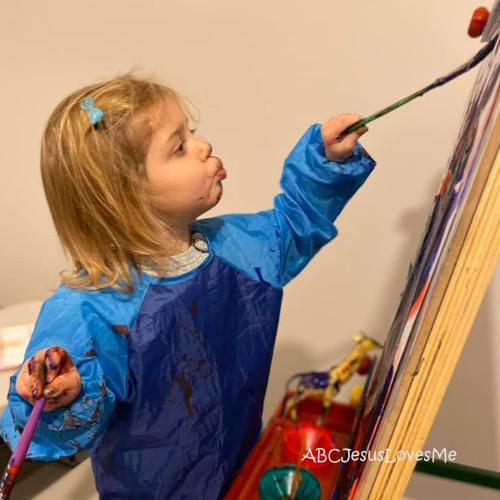
Painting is a fantastic way to develop fine motor skills, as it requires children to control their hand movements while holding a brush. Starting with larger, stubby brushes helps young children strengthen their grip and practice coordination. Whenever possible, place the paper on a vertical surface, as this engages additional muscles in the wrist and hand that aren’t used as much when working horizontally. The ABCJesusLovesMe 1-5 Year Curricula strategically incorporates age-appropriate painting activities throughout.
Pushing together, pulling apart, and stacking blocks are excellent ways to develop fine motor skills, as children use their hands to manipulate and position each block. Starting with larger blocks helps young children build grip strength and coordination. As they progress, stacking blocks encourages balance and spatial awareness, while locking blocks like Legos help develop precision and hand-eye coordination, as children snap pieces together.

Before my children turned one, I would sit on the floor with them, building towers while saying, "Wait...wait." Once the tower was complete, I’d say, "Go!" and let them knock it down. Sometimes, I gently held their arms to help with the waiting. This simple activity helped them learn obedience, patience, and self-control. As their ability to wait improved, I built larger towers, extending the wait time.
Interlocking blocks come in various shapes and sizes. Start with larger blocks that are easier to grasp and move to smaller ones as the child's fine motor skills develop. Quatro and Duplo Legos are my favorites for toddlers, while smaller Legos are best saved for when children are ready for detailed placement. I’ve found that some off-brand blocks don’t fit well, so check before purchasing. It's important to balance imaginative building with following Lego instructions, as both skills are valuable.

Wooden blocks are wonderful because they require careful balancing and a solid foundation to support structures. By certain ages, children should be able to stack a specific number of blocks:
Beyond wooden blocks and Legos, my children enjoyed playing with the following as each provided a little different learning:

Is ABCJesusLovesMe the right fit for your preschool, daycare, or church? All your questions can be answered during a private remote meeting.
Please note that remote sessions are exclusively for institutions and are not available to individual families.
Quality games are a fun and effective way to help young children build fine motor skills while promoting other areas of learning. Whether through stacking, sorting, or problem-solving, games encourage hand-eye coordination, dexterity, and concentration. As children engage in these activities, they also strengthen their cognitive and social skills, all while having a blast! Here are some of the best for building fine-motor strength.
Water-based play is an excellent way for young children to develop fine motor skills while also encouraging creativity and problem-solving. Activities like squeezing sponges, using squirt bottles, or transferring water between containers help strengthen hand muscles and improve coordination. As children engage with water, they also enhance their cognitive skills, sensory awareness, and social interactions in a fun, hands-on environment.
- Pour water between containers. Do this activity in the bathtub or outside for limited mess.
- Squeeze a sponge full of water from one bucket to another or on a chalk drawing on a sidewalk.
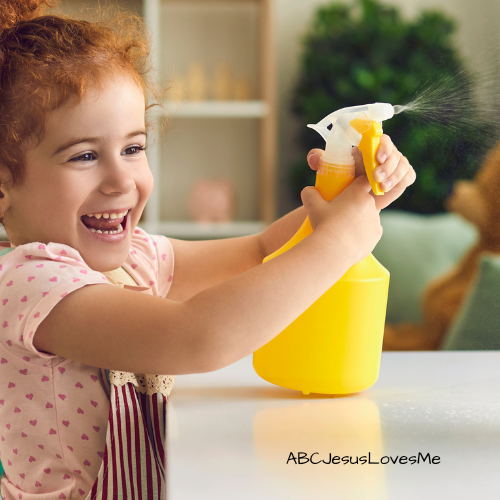
My kids loved using squirt bottles during bath time, for cleaning, or to cool off in the summer. Let your child spray water from a quality spray bottle (avoid inexpensive ones that are hard to squeeze) onto shaving cream to wash it away. If snow is available, add a few drops of food coloring to a spray bottle filled with water for a colorful outdoor activity. For extra fun, spray shaving cream onto the walls of a shower or bathtub allowing the child to spray off with water. The squeezing motion helps strengthen the hand muscles needed for holding a pencil and controlling scissors.
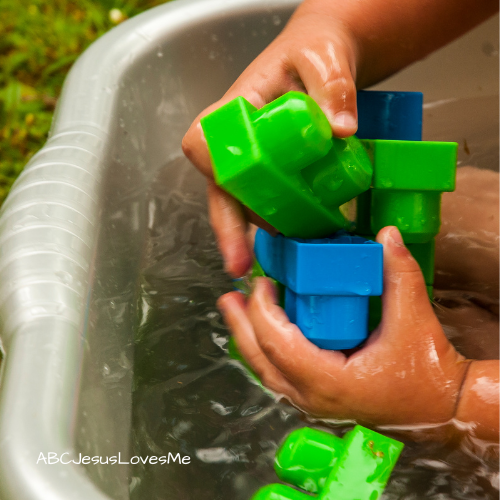
Construction-type play helps develop fine motor skills by requiring children to manipulate and assemble various materials. Examples include:
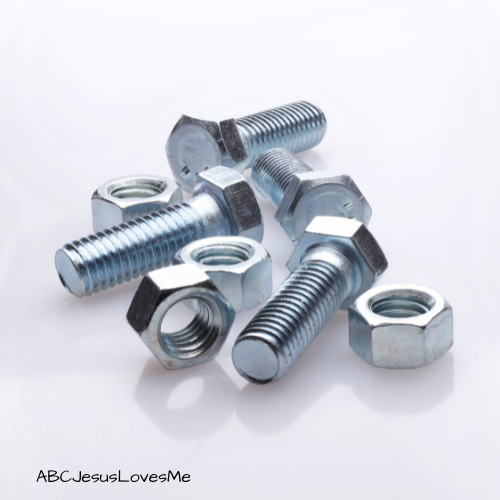
Provide the 3+ age child with several large nuts and bolts to screw together, strengthening hand and finger muscles.

Pretend to hammer nails by hammering golf tees into Styrofoam or play dough.
From tiny tots to preteens, our chore chart is designed to help your child develop valuable life skills while keeping your home running smoothly. Make chores fun and rewarding for the whole family! Download now and see the positive impact on your child's development.
Pinching and squeezing activities are excellent for developing fine motor skills by strengthening the small muscles in a child’s hands and fingers. Using items like clothespins, tweezers, and tongs, children can practice picking up small objects such as pom-poms, cotton balls, or beads.
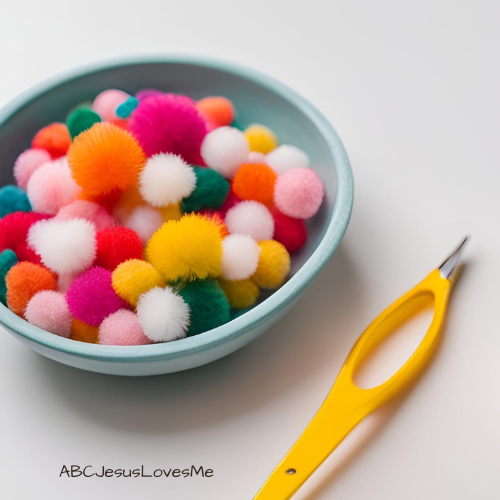
Place a bowl of craft pom poms or cotton balls on the child's right side and an empty bowl on the left. Provide plastic tweezers, tongs, or clothespins, and have the child use these tools to transfer each pom pom from one bowl to the other. Afterward, switch the bowls so the child moves the pom poms from left to right. This activity supports fine motor skills and encourages crossing the midline, which is important for overall coordination and brain development.

- Have the child match colored clothespins to corresponding colored cards or paper.
- Write numbers on a card and ask the child to clip the corresponding number of clothespins onto the card.
- Set up a clothesline and have children use clothespins to hang small fabric pieces or paper items.
- When the temperature dip below freezing, saturate t-shirts, towels, or other fabric items to hang outside. Then watch to see how fast each item freezes. The kids will love it and won't even realize they are learning about science!
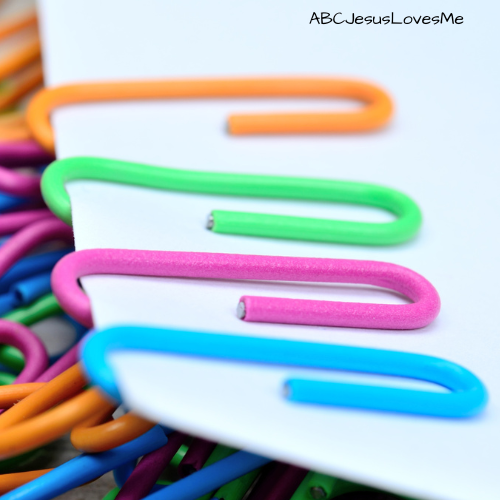
Align clothes pins, hair bobby pins, or paper clips on a stiff piece of paper.
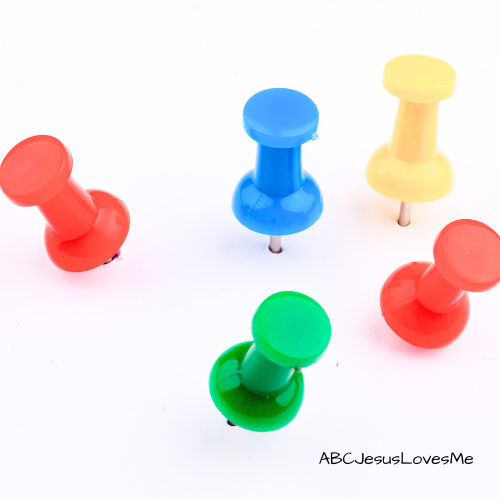
For children 3+ age, draw a large shape (e.g. circle, square) on a place a piece. Place the paper on the carpet. Using a push pin, instruct the child to punch around the edge of the shape until the shape is free from the paper.
The ultimate goal of fine motor skills is to equip a child with the life skills needed to dress, write, play an instrument, and handle small objects. The activities listed above can help prepare them for these tasks. Here are additional ideas to strengthen a child's fine motor skills and develop the correct pencil grasp through coloring and drawing.
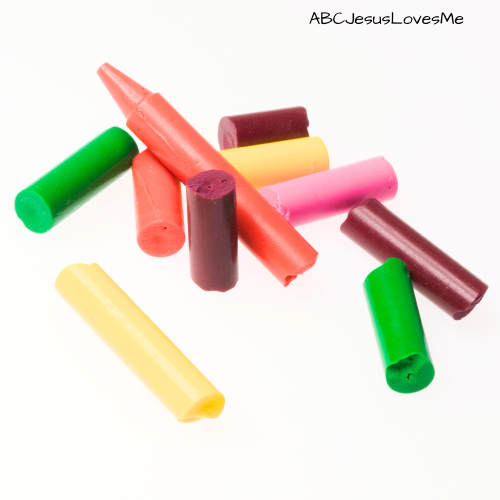
Throughout the Preschool Curriculum, it is recommended that toddlers use egg-crayons and preschoolers use broken crayons for coloring and writing.
Occupational therapists have found that crayons shorter than 1" encourage proper grip, preventing the development of bad habits. The goal is for the child to hold the utensil with the thumb and index finger, while resting it on the middle finger. Markers and pens are greatly discouraged for craft and writing activities, as they do not strengthen fine and gross motor skills as effectively as crayons and pencils.
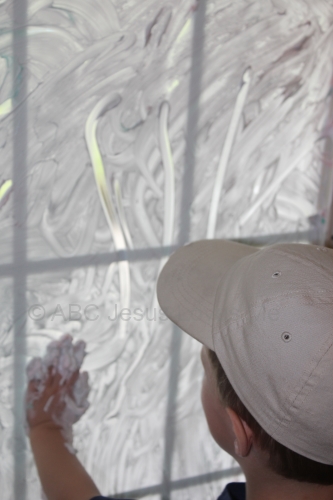
Whenever possible, place the paper on a vertical surface, as this activates additional muscles in the wrist and hand that aren't as engaged when working on a flat surface. Place shaving cream on a glass door or shower wall for the child to move above or write.
Another creative option is to have the child draw while lying on their back. Tape a large sheet of paper underneath a table, and let the child lie down and draw for fun, creating simple shapes on the paper above them.
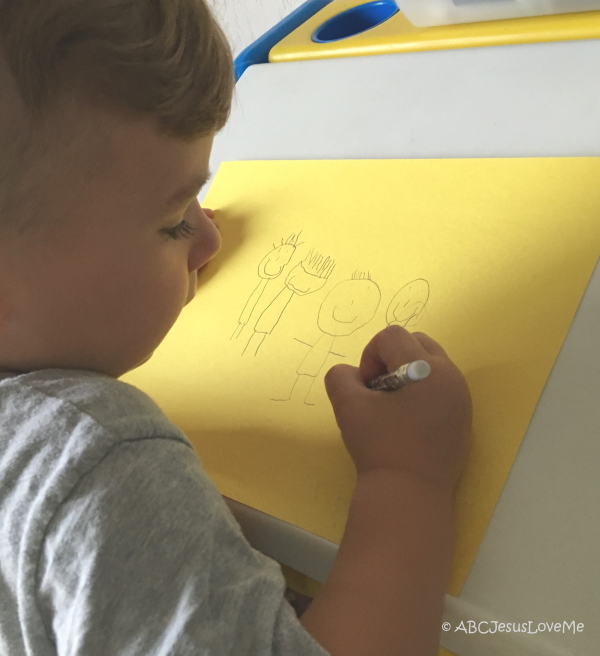
Periodically ask a child to draw his family. This can be a daunted task for some children. Begin by demonstrating how to draw a person. Use simple shapes for parts and explain what you are doing as you draw. Let your child assist in the process. Later in the week, give your child a chance to try it himself. For more ideas read, "Teaching Your Child How to Draw."